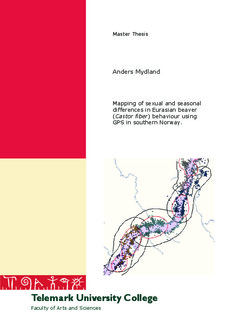| dc.contributor.author | Mydland, Anders | |
| dc.coverage.spatial | Norway | |
| dc.date.accessioned | 2016-01-19T14:01:52Z | |
| dc.date.accessioned | 2017-04-19T13:13:38Z | |
| dc.date.available | 2016-01-19T14:01:52Z | |
| dc.date.available | 2017-04-19T13:13:38Z | |
| dc.date.issued | 2016-01-19 | |
| dc.identifier.citation | Mydland, A. Mapping of sexual and seasonal differences in Eurasian beaver (Castor fiber) behaviour using GPS in southern Norway. Master thesis, Telemark University College, 2014 | |
| dc.identifier.uri | http://hdl.handle.net/11250/2438907 | |
| dc.description.abstract | In mammals monogamy is often characterized in mammals by reduced sexual dimorphism. Beavers, being a monogamous species are hard to observe, due to their nocturnal and semiaquatic nature. In this study I used GPS technology to determine territory size and overlap of the Eurasian beaver (Castor fiber). I tested the hypothesis that beavers present no sexual, behavioural dimorphism by measuring activity patterns and territory size. I also predict that there are some differences in behaviour between spring and autumn. Whilst in addition investigating the usefulness of GPS technology in this environment. 27 dominant, territory holding Eurasian beavers, 11 females and 16 males, were fitted with GPS transmitters from 2009-2014. I analysed territory size, territory overlap and activity start and stop times. GPS tags were deployed for an average of 13.1 ± 4.3 days with a fix rate of 15 minutes and territory size was calculated using 95% and 50% Kernel density estimator. My analyses show that beavers do not display behavioural sexual dimorphism. I found significant differences in territory overlap between spring and autumn, with a total overlap of 2.1% ± 2.1% in spring and 12.0% ± 8.0% in autumn. There were no seasonal differences in the time the beavers emerged from the lodge. However there was a significant difference of the return time. In spring they returned on average at 06:05 ± 00:44 whereas in the autumn beavers returned to the lodge at 06:44 ± 00:44. These results suggest that beavers do not present sexual dimorphism. In addition my study shows that GPS technology helps us in defining territories and movement patterns with high precision and reducing tracking efforts and costs for researchers. | |
| dc.language.iso | eng | |
| dc.publisher | Høgskolen i Telemark | |
| dc.subject | beaver | |
| dc.subject | GPS | |
| dc.subject | Castor fiber | |
| dc.subject | territory | |
| dc.subject | activity | |
| dc.subject | behaviour | |
| dc.title | Mapping of sexual and seasonal differences in Eurasian beaver (Castor fiber) behaviour using GPS in southern Norway. | |
| dc.type | Master thesis | |
| dc.description.version | Published version | |
| dc.rights.holder | © Copyright The Author. All rights reserved | |
| dc.subject.nsi | 480 | |
